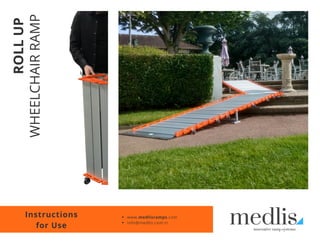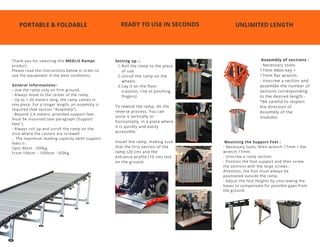Portable Roll Up Wheelchair Ramp User Manual
- 2. Thank you for selecting this MEDLIS Ramps product. Please read the instructions below in order to use the equipment in the best conditions. General Informations:┬Ę - Use the ramp only on firm ground, - Always move to the center of the ramp. - Up to 1.20 meters long, the ramp comes in one piece. For a longer length, an assembly is required (See section "Assembly"). - Beyond 2.4 meters, provided support feet must be mounted (see paragraph (Support Feet"). - Always roll up and unroll the ramp on the slice where the casters are screwed - The maximum loading capacity (with support feet) is : Upto 80cm : 500kg. From 100cm ŌĆō 1000cm : 350kg PORTABLE & FOLDABLE READY TO USE IN SECONDS UNLIMITED LENGTH Roll the ramp to the place of use. Unroll the ramp on the wheels. Lay it on the floor (caution, risk of pinching fingers) Setting up :- 1. 2. 3. To rewind the ramp, do the reverse process. You can store it vertically or horizontally, in a place where it is quickly and easily accessible. Install the ramp, making sure that the first section of the ramp (20 cm) and the entrance profile (10 cm) rest on the ground. Assembly of sections : - Necessary tools: 17mm Allen key + 17mm flat wrench. - Unscrew a section and assemble the number of sections corresponding to the desired length.- *Be careful to respect the direction of Assembly of the modules. Mounting the Support Feet : - Necessary tools: Allen wrench 17mm + flat wrench 17mm. - Unscrew a ramp section. - Position the foot support and then screw the sections with the large screws.- Attention, the foot must always be positioned outside the ramp. - Adjust the foot heights by unscrewing the bases to compensate for possible gaps from the ground.


